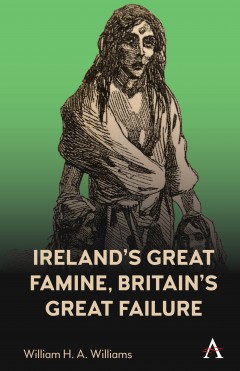Ireland’s Great Famine, Britain’s Great Failure
By William H. A. Williams
- About This Book
- Reviews
- Author Information
- Series
- Table of Contents
- Links
- Podcasts
About This Book
Most books about the Irish Famine tend to take Ireland’s reliance on potato for granted and treat the arrival of the deadly blight in 1845 as merely the trigger event that launched a humanitarian crisis—one that the British government famously failed to manage. In this work, considerable attention is paid to the origins and nature of Ireland’s dangerous potato dependency. Although introduced into Ireland as a cultivated plant, the potato nevertheless had the impact of an invasive species, disrupting and reorganizing Irish agriculture. Drawing upon ecology and systems theory, this study provides a detailed account of the intricacies of Ireland’s potato economy built upon an unstable and unsustainable monoculture that became a cybernetic trap.
When almost the whole potato crop failed in the fall of 1846, what began as an ecological disaster quickly became a political one. Hampered by long-standing prejudice and Anglo-Irish tensions, the British government’s various attempts to deal with the humanitarian crisis were muddled by competing economic and social goals. Among these was the idea that the Famine represented an “opportunity” to purge Ireland of fragmented land holding and potato dependency by encouraging an English-type market-driven agriculture. Changes did occur, but the government’s imperial dreams eventually ran up against Irish realities.
This book provides readers with a unique, in-depth understanding of the background to the Irish Famine and a detailed account of the crisis, as well as the immediate and long-term results of the catastrophe. In addition to ecological and agriculture factors, this work shows how cultural, economic and political influences shaped British attitudes and policies. Although Britain’s policies reflected anti-Irish prejudices, it was not the “Irish people” who were the victims of the Famine, but rather the Irish poor. By the mid-1840s, Great Britain was an emerging, middle-class democracy imbued with a faith in free markets and a deep suspicion of the poor, English as well as Irish. The Government’s response to the Irish Famine reflects the problems democracies often have setting aside class and racial prejudice in order to deal with humanitarian crises.
Reviews
“This book presents fresh perspectives on crucial socio-economic pressures, cultural currents, and ecological factors that shaped the Great Famine’s course and outcomes. Written with a keen understanding of contemporary political actions and attitudes, its integrative, contextualized approach contributes an innovative retelling of the Famine’s history to the field.” — Mary C. Kelly, Franklin Pierce University, US.
Author Information
Dr. Williams is a retired historian, writer and musician who has taught in Ireland, Germany and America. He has published books and articles about Irish-America and Irish history, including Inventing Irish Tourism, The First Century, 1750-1850.
Series
Table of Contents
List of Figures; Preface; Introduction; Part One Culture, Religion and Politics in the Pre-Famine Decades; Chapter One The Colonial Background; Chapter Two From Stereotypes to Narrative: The Making of the Irish Other; Chapter Three Politics and Religion in the Age of Daniel O’Connell; Chapter Four Morality and Economics in the Age of Atonement; Part Two The Rise and Fall of the Ireland’s Potato Economy; Chapter Five Poverty and Inequality: The Economic Background; Chapter Six People, Land and Potatoes; Chapter Seven Phytophthora infestans and the Collapse of the Potato Economy; Part Three The Famine Years; Chapter Eight The Arrival of the Potato Blight: 1845–46; Chapter Nine The First Phase of the Famine: Black ’46–’47; Chapter Ten A False Dawn: 1847–48; Chapter Eleven The Return of the Blight: 1848–49; Chapter Twelve Years of Evictions: 1849–52; Part Four The Post- Famine Years; Chapter Thirteen Post- Famine Dreams and Irish Realities in the 1850s; Chapter Fourteen In the Famine’s Wake; Conclusion; Bibliography; Index.
Links
Stay Updated
Information
Latest Tweets



